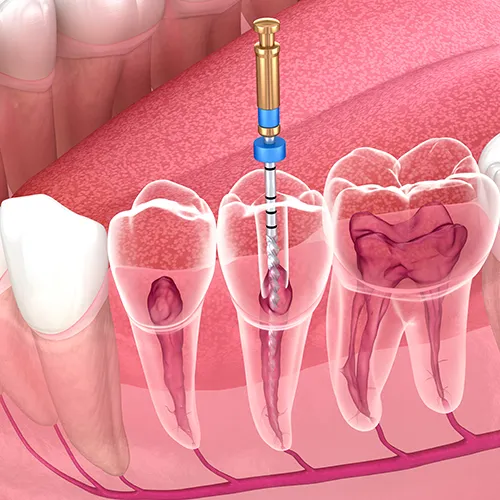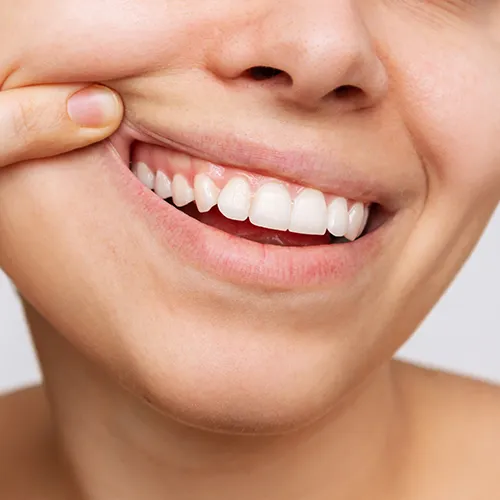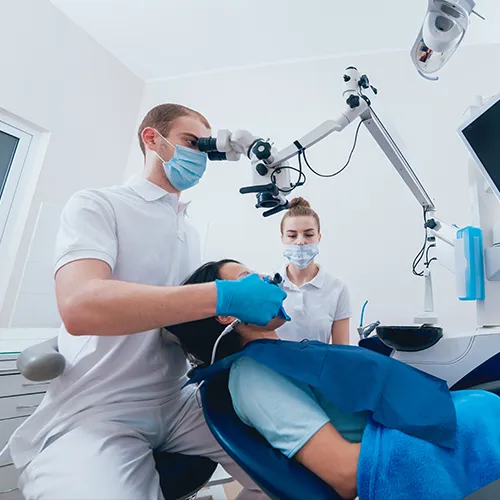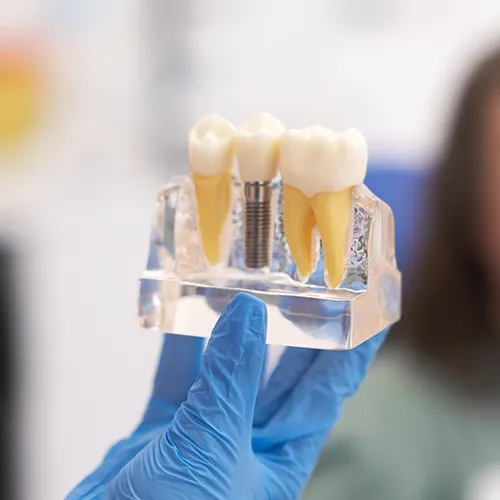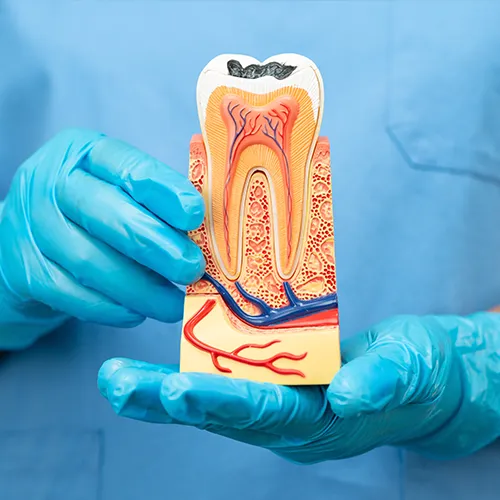Emergency Dentistry
So, About That Root Canal You’ve Been Dreading…
Everyone has heard at least one horror story about root canals. The phrase itself may bring up images of a throbbing toothache, dreaded dental drills, or a friend who insists they’d rather do anything else than sit in that dentist’s chair. But here’s the truth: root canals have come a very long way, and the process is far smoother and more comfortable than it used to be. In fact, many of our patients at Akemi Dental Specialists are often pleasantly surprised at how pain-free and straightforward the treatment can be. So, if you’re reading this with a bit of hesitation—maybe because you’ve been told you need a root canal or you’re just curious about it—let’s walk through what it’s really all about.
1. Is the root removed during a root canal?
A lot of folks think a root canal actually removes the root of your tooth, but that’s not the case. The name can be a little misleading. The “root canal” refers to the channel—or canal—inside your tooth’s root, where the pulp and nerve tissue reside. During treatment, the infected or inflamed pulp is removed from within this canal. However, the root of your tooth, which is embedded in your jaw, stays right where it is.
We then disinfect and shape the canal to ensure no harmful bacteria remain. After that, we fill it with a specialized material called gutta-percha. This material seals off the space to help prevent reinfection. Finally, the tooth is usually capped with a crown or a filling to strengthen it. By removing the infected pulp but leaving the tooth structure in place, we can preserve much of your natural tooth while eliminating pain and infection.
The Recovery Process and Preventing Future Problems
Root canal recovery is often easier than people expect. You may have some soreness or mild discomfort for a few days—similar to what you might experience after a regular filling—but over-the-counter pain relievers often do the trick. We’ll likely ask you to avoid chewing on that side of the mouth until your permanent restoration (like a crown) is in place. After that, you can go back to your normal diet (maybe holding off on super-hard foods for a bit if you’re still adjusting).
Long-term, good oral hygiene is key. Brushing twice a day, flossing daily, and scheduling regular cleanings are the best ways to ensure your restored tooth remains healthy. A routine checkup can help us catch any issues early, and it’s always a good idea to let us know if you notice any changes like unusual sensitivity or discomfort.
2. Can you get two root canals in a day
This is another question we hear from time to time, especially when patients learn they have more than one tooth with deep decay or infection. The reality is that, medically speaking, it is possible to do more than one root canal in a single day. However, whether or not this is recommended depends on various factors:
1. Your Comfort: While each individual root canal is usually painless (thanks to local anesthesia), having multiple procedures back-to-back can mean extended time in the chair. Some people might be comfortable with that; others may prefer separate appointments.
2. Complexity of the Cases: Not all teeth are created equal. Some have multiple canals that are more curved or more challenging to clean. If two teeth are relatively straightforward, doing both in one visit could be practical. But if they’re complicated, spreading out the procedures might be best for both you and your dentist.
3. Scheduling Flexibility: Sometimes, patients live far away or have demanding schedules, so consolidating treatment makes sense. Your dentist will consider your situation and the overall complexity before recommending one or two appointments.
At Akemi Dental Specialists, we strive to make treatment as convenient and comfortable as possible, so if you do need multiple root canals, we’ll talk through your options. We’ll figure out a timeline that feels right and ensures the best possible outcomes for your teeth.
3. Can teeth shift after a root canal?
One worry we sometimes hear is that your teeth might shift out of alignment once you’ve had a root canal. In most scenarios, there’s no reason for your teeth to move just because you’ve had the pulp removed. The tooth still remains anchored in your jaw by its roots. The only time shifting might become an issue is if a tooth was so compromised that it needed to be extracted, and you decided not to replace it with an implant, bridge, or other prosthetic.
When a gap is left in your mouth (from an extraction), your other teeth can gradually drift toward the open space. This is one of the many reasons we suggest maintaining or replacing a tooth sooner rather than later. With a successful root canal, the structure of your tooth remains in place, so there’s minimal risk of your teeth shifting out of alignment. Keep in mind, if you’ve been recommended for orthodontic treatment or if you’ve had some shifting due to gum or bone issues, that’s a different conversation altogether. But in general, a properly restored tooth post-root canal does not cause teeth to shift.
Caring for Your Smile Over the Long Haul
A root canal isn’t just about ending tooth pain—it’s an investment in your long-term health. By preserving your natural tooth, you’ll keep your bite aligned and maintain a confident smile. It also saves you money and hassle in the future since you won’t need a more extensive procedure later on if the tooth were to become too damaged.
The best part is that a root canal and a beautiful crown can last for many years with proper care. Here’s how to help it go the distance:
Stick to a diligent routine: Brush at least twice a day, floss regularly, and consider using an antibacterial mouthwash if recommended by your dentist.
Don’t skip dental visits: Regular checkups allow us to monitor the health of your tooth and any crown or restoration you have.
Mind your diet: It’s okay to indulge in sweets occasionally, but a balanced diet low in added sugars and high in vitamins helps keep your teeth strong and your gums healthy.
Manage stress: Oddly enough, stress can lead to teeth grinding (bruxism), which can put extra pressure on restored teeth. If you’re a grinder, a custom night guard might help protect your investment.
When It’s Time to Take Action
If you’ve got a lingering toothache, sensitivity to hot or cold, or you just can’t shake that nagging feeling something isn’t right with your tooth, it’s time to give your dentist a call. The sooner you address any infection or inflammation, the simpler (and often less expensive) your treatment will be. And if you’re reading this and thinking, “I can handle a bit of pain,” remember that dental problems rarely go away on their own. If anything, the discomfort tends to increase, and you risk spreading infection or requiring a more involved procedure in the future.
Root canals are just one aspect of taking care of your oral health. By being proactive, you can maintain a strong, confident smile for decades. And trust me, you don’t have to endure nights of lost sleep or constant tooth pain thinking you’re doomed to an agonizing procedure. With modern techniques, sedation options, and a caring dental team, you’re in good hands.
Ready for a Happier, Healthier Smile?
If you suspect you need a root canal or simply haven’t had a checkup in a while, we invite you to schedule an appointment with Akemi Dental Specialists. Our friendly, experienced team will walk you through every step. We’ll make sure you’re comfortable, well-informed, and confident in your decision—whether that involves a root canal or any other treatment. There’s no reason to suffer in silence when help is just a phone call or a click away.
Remember, your smile says a lot about you. Taking care of it not only ensures you can eat and speak comfortably, but it also boosts your self-esteem—because nothing’s quite as infectious as a wide, genuine grin. We believe everyone deserves to feel great about their teeth, and we’re here to help you achieve that in a caring, professional environment.


